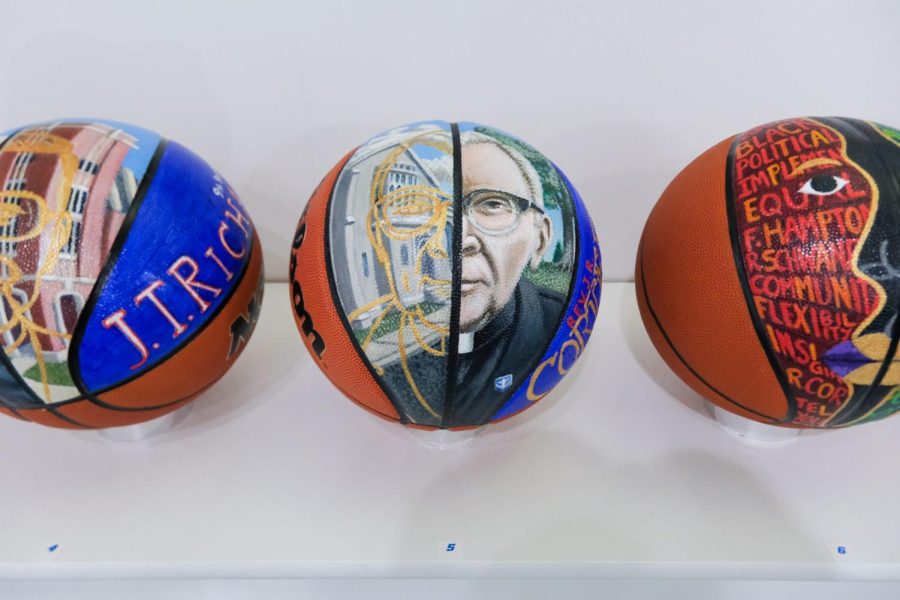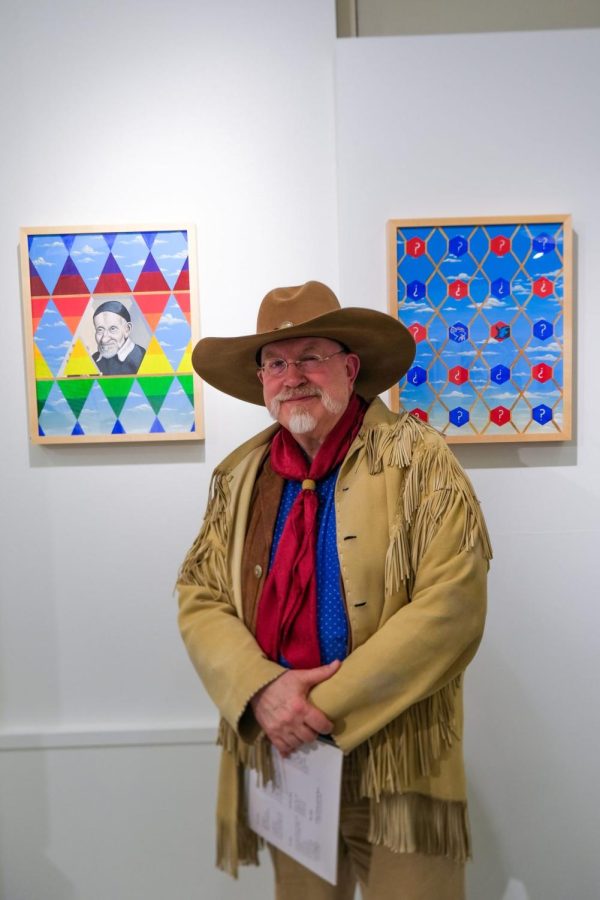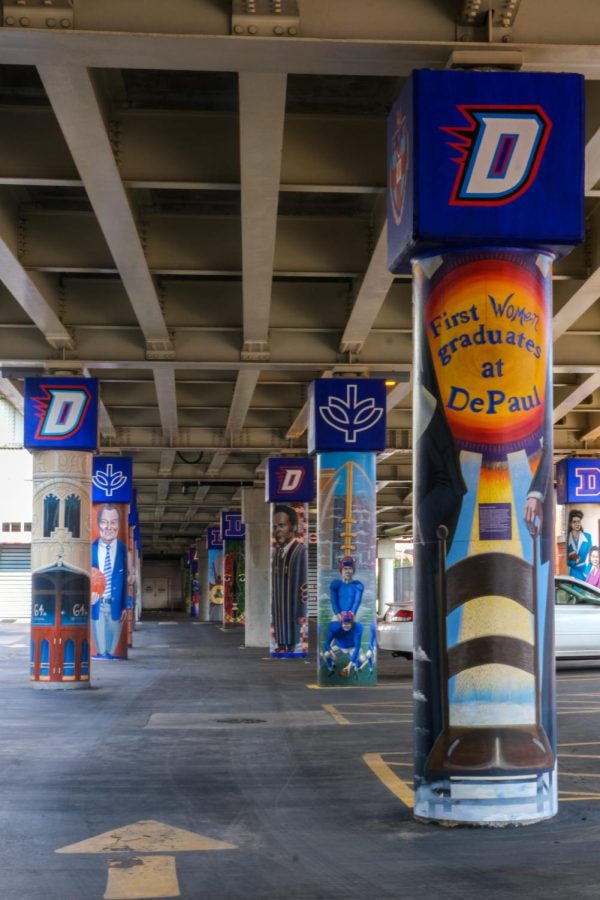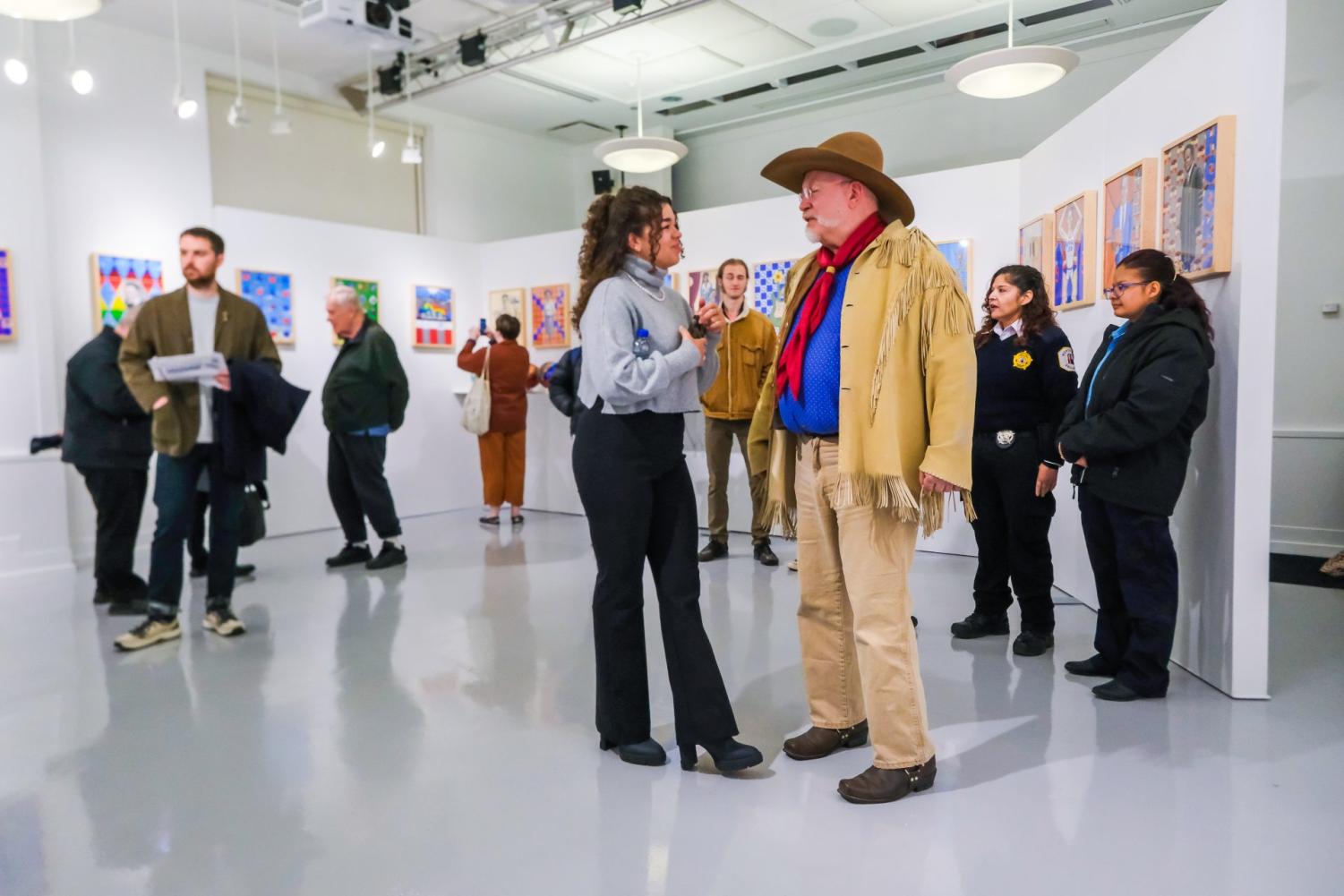“The Little School Under the L:” a story of growth and mission throughout DePaul’s history
January 15, 2023
Twenty-five brightly colored canvases adorn the walls of the Richardson Art Gallery on DePaul’s Lincoln Park Campus. From a distance, their content appears unrelated. However, a closer step reveals the truth: they are the faces and organizations of DePaul’s past, present and future.
While the gallery’s current showcase, “Behind the Pillars” is only a glimpse into the true exhibit, “The Little School Under the L,” it invites viewers to venture beneath the Fullerton stop and admire the towering murals. Comprised of portraits, landscapes and designs, the 25 murals narrate a story spanning more than 400 years, from the time of St. Vincent DePaul, to Chicago’s ongoing battle with Covid-19.
Although the wooden frames highlight details imperceptible to their larger-than-life counterpart displayed on the Chicago Transit Authority’s 10-foot-tall pillars beneath Red and Brown Line, the exhibit allows gallery goers to reflect on their knowledge of the University’s colorful history.

Led and curated by DePaul Art School faculty member Mark Elder, better known as “Brother Mark,” the community-supported public art project began as a way to fill space.
“I was struck with the notion of doing it [the murals] since 2010,” Elder said. “All of those pillars had a good deal of conversation that went into them. Some of them were no-brainers, you know, you look at the whole of DePaul’s history and immediately some names just leap out at you right away.”
Starting in 2016, the more than seven-year project kicked off with contributions from students in Elder’s creating murals class. The project gradually grew, acquiring help from individuals inside and outside the DePaul community.
“Murals is what I do,” Elder said. “My main output in art is to do community supported public art, so the pillars, the big Vinny and other murals that I’ve done were always through the focus of having a community dialogue.”

The process of choosing who and what to put on each pillar was settled through an open discussion between the university, Elder and DePaul’s vibrant community. However, Elder knew from the beginning he needed to highlight even lesser-known figures for individuals to understand DePaul’s history.
“We have a pillar there for the first lay woman graduate of DePaul,” Elder said. “She was teaching at the age of 16 back in the 1880s, but she wanted more for herself, and the only place that would let her do it in 1912 was DePaul.”
Throughout Elder’s 28 years at DePaul, he has created several iconic murals, like his 2001 portrait of St. Vincent de Paul on McCabe Hall titled “We Are DePaul 2.” However, Elder’s talent is not restricted stateside. His mural, “The Vincentian Family: The Gleaners,” resides in the Vincentian headquarters in Rome.
On top of the 25 pillars, Elder hand-painted 17 basketballs, each holding a variation of their pillar design. The ball dedicated to Joe Wilhoit, who made it to Major League Baseball as a player after graduating from DePaul in the early 1900’s, includes a miniature portrait of Wilhoit accompanied by baseballs and cleats. After the exhibit ends, the basketballs will be given to the families of the individuals honored in the pillars.
“The notion of a painted basketball is kind of curious,” Elder said with a laugh. “I harken it to the notion of a basketball award given to one of the basketball players… The basketball itself is symbolizing something valued on a high level for the DePaul community because that’s how we look at basketball as an activity because of its history.”
While “The Little School Under the L” may have just reached completion, it has already impacted students at DePaul.
“I was in Brother Mark’s internship class like a year ago, and he mentioned that he normally does a mural class in the spring, which was the reason I signed up for an art major this fall,” said senior Meg Sampson.
Soon after, Sampson found herself directly involved with the project.
“[Elder] was mentioning that because of the timing of it, he wasn’t offering [his creating murals class] and I was super bummed about that,” Sampson said. “But then he mentioned that he was thinking of recruiting a few students to work with it, and just based on expression alone he asked me if I would be interested.”

Over 100 students aided in the mural’s creation. However, some students, such as senior Tayvia Ridgeway, found themselves more engaged than others.
“I started [with the murals] all the way in my freshman year,” Ridgeway said. “When I first came to DePaul and enrolled in Discover classes, I was initially in a different one, but then I saw there was an option for murals around Chicago and I knew that was the perfect thing for me.”
Despite Elder’s Chicago art and mural-centric class being full by the time Ridgeway discovered it, she immediately reached out to Elder and asked to join.
“Since then, I’ve worked with him helping install the murals, helping him paint them over the summer and prep for them,” Ridgeway said. “I basically did it every year since my freshman year, and then he finally gave me a chance to do the final mural for the whole pillar installation. That was really like a great, great honor.”
Titled “End of Trail,” Ridgeway’s pillar colorfully commemorates the names of everyone involved with the project and its themes of memorialization, mission, as well as her own background as a black woman native to Chicago.
Despite spending over a thousand hours working on the mural, when asked about her favorite memory from the project, her answer remained close to home.
“I feel like just working in the studio with Brother Mark is something I won’t forget,” Ridgeway said. “My grandfather actually, he used to do art and I didn’t really have that connection with him … he did pass [away] earlier on. And I feel like Brother Mark is kind of that relationship to me now, of doing art and being that figure in my life, and it means so much to me.”
While “Behind the Pillars” may only be in the Richardson gallery until March 9, Elder, alongside his students, has high hopes that “The Little School Under the L” will stand tall for the uncharted years to come.
